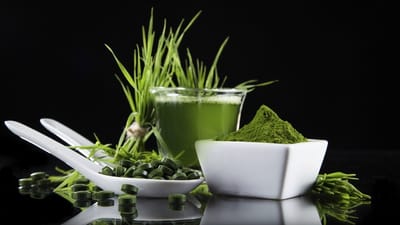MICRO-ALGAE & NUTRITION


We will only talk in this paragraph about the best known micro-algae: Spirulina considered by the WHO as the super food of the 21st century for humanity.
Spiruline is a cyanobacteria, or blue-green micro-algae, that appeared on Earth 3.5 billion years ago, particularly recognizable for its 0.2-0.5 mm long spiral shape.
These single-celled organisms, capable of photosynthesis, lie at the root of the development of all terrestrial plants and led to emergence of aerobic living beings.
Found on all continents besides Antartica, bue-green micro-algae comprise 1,500 different species, of which 36 are edible.
Spiruline is recognized as one of the richest foods on the planet. Its many benefits are linked to its extraordinary composition.
Spiruline is mostly composed of proteins, containing all of the amino acids that are essential to our body.
Spirulina is contains Minerals, vitamins, and pigments
The most relevance of inorganic micronutrients in Spirulina is Potassium, magnesium, calcium, zinc, phosphorous and iron. They are important for nutrition human body. Iron can help to improve anaemia and hypertensive disorders. Phosphorus and calcium are comparable to those in milk. The proportion (Ca:P) of this micronutrient is compatible with the bone health to reduce decalcification. The iron, calcium and phosphorous content of Spirulina are 1.7, 15, and 10 mg, respectively.
Vitamins, Minerals and pigments composition of Spirulina (per 1g sample) :
Vitamins composition
Biotin - 0.55 ug
Folic Acid - 0.71 ug
Pantothenic Acid - 2 ug
Cyanocobalamin (Vitamin B12 )- 3.6ug
Pyridoxine (Vitamin B6) - 8 ug
Thiamine (Vitamin B1) - 48 ug
riboflavin (Vitamin B2) - 55 ug
Niacin (Vitamin B3) - 0.15 mg
Tocopherol (Vitamin E) - 0.41 mg
Inositol Acid - 0.7 mg
Beta-carotene (pro-vitamin A) - 5.8 mg
Bioflavonoids - 10 mg
Minerals composition
Potassium (K) - 16 mg
Calcium (Ca) - 15 mg
Phosphorus (P) - 10 mg
Manganese (Mn) - 3 mg
Zinc (Zn) - 70 ug
Magnesium (Mg) - 3.7 mg
Sodium (Na) - 2.5 mg
Pigments
Phycocyanin - 180 mg
Chlorophyll - 11 mg
Total Carotenoids - 6mg
Iron (Fe) - 1.7 mg
The dried powder Spirulina contains some of the vitamins like Thiamine, riboflavin, Niacin, Pyridoxine, Cyanocobalamin, and Tocopherol. One of the important and complex vitamins is cobalamin (vitamin B12). It is very important because vitamin B12 is only contained in animal origin foods. according to Table 1, the cyanocobalamin (B12) content of Spirulina about 3.6 g. The Spirulina is also known as a good beta-carotene source because it is containing about 5.8 mg g-1. beta-carotene will be absorbed to bio-transformed into vitamin A. Human body requirement of vitamin an about 1 mg/day, therefore 1-2 g of Spirulina will be sufficient for this need.
The phycocyanin, chlorophyll, and carotenoid are an important group of pigment found in Spirulina. Carotenoid is played as lipophilic antioxidants and responsible as an anticancer agent. The pigment component of Spirulina showed in Table 1. The contains both of the phycocyanin, chlorophyll, and carotenoid were 180.11 and 6 mg, respectively.
The Spirulina can be categorized as a superfood, because of its high nutrient content. Spirulina contains nutrients like protein, vitamins, essential fatty acids, amino acids, minerals, and phytonutrients. The high phytonutrient content of Spirulina can be considered an alternative food for vitamin supplements.
references : Deasy Liestianty et al 2019 IOP Conf. Ser.: Mater. Sci. Eng. 509 012031